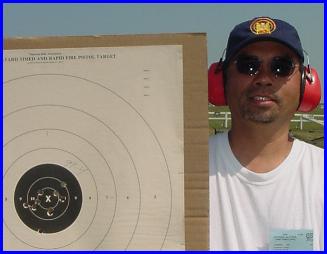
Greetings Shooters and Happy Holidays,
The ideal pupil, .......no, I'm not referring to our kids at school. Why does one shooter see exceptionally well while another shooter does not? I'm referring to shooters with identical ages, eyeglass prescriptions, and corrected maximum visual acuities. There are other variables which come into play while we sight our guns, one of which is "pupil size," and it appears that very little attention has been given to this topic.
We generally have no control over our pupil size, but an understanding of how the pupil can affect our seeing may help determine solutions for our vision problems. Quite by accident, I was reading the vision section of the U.S. Army Marksmanship Unit, Pistol Marksmanship Training Guide and discovered that a pupil size of approximately 3 millimeters was considered ideal for best vision. I did a little more research so that I may either confirm or dispute this claim. I don't always believe everything I read.
One source from my research stated that "2 mm." was the ideal size for best vision, while another source quoted "3 to 4 mm." as being the best size. One important note from my findings was that the "depth of focus" increases by 0.12 diopter for every millimeter change in pupil size from 8 mm. to 2.5 millimeters. What this means is that with smaller pupils, we see with a greater depth of focus which is important for our iron sight guns. At arm's length, a 0.50 diopter increase in the depth of focus will extend the range of clear vision by approximately 35 cm. which is about 12 inches. This is why shooter #1 (with ideal sized pupils) sees the front and rear sights well while shooter #2 (with large pupils) may not. The bull may also be more blurry for shooter #2 and not so much for shooter #1.
What happens with too small of a pupil? Well, we have a condition known as diffraction which causes interference. Light rays are no longer straight as they pass by an edge such as our iron sights, or even the round edge of our pupil margins. It is generally agreed upon that a pupil size less than 2 to 3 mm. will cause these diffraction interferences. It is important to understand that pupil size does decrease with aging, which may be another reason why some of us may not see as well as we become older.
Pupil sizes larger than 3 to 4 mm. may show signs of spherical aberrations, which would also affect our firearm sight focus, the red dot as well as irons. The very front portion of our eyes is known as the cornea and most of the focusing occurs here rather than with our crystalline lens. The central portion of the cornea provides the best focus while the peripheral cornea does not. Besides causing a more shallow depth of focus, a larger pupil would allow peripheral light rays to enter the eye and affect the central light rays, and would therefore increase blur.
Why is all this talk about pupil size of any importance to shooters? Well, those with larger pupils may be aided by using an adjustable aperture if better vision is desired while sighting. I'm not referring to increasing depth of field, but to improve overall vision by decreasing or eliminating spherical aberrations. Those with very small pupils may be aided with the use of tinted lenses which would help to dilate the pupils. In this case, I'm not suggesting tinted lenses for sun protection, but to reduce diffraction interferences.
The most common complaint I hear from shooters who say they don't see the red dot or iron sight well is because they "think" they have astigmatism even after wearing their new eyeglasses. However, after all refractive errors have been compensated for with the use of new eyeglasses, vision should be perfect, unless the pupil size is not ideal.
Good Vision and Good Shooting To All,
Norman H. Wong, O.D.
